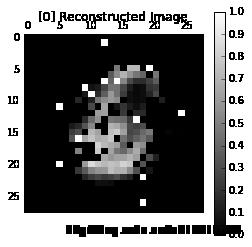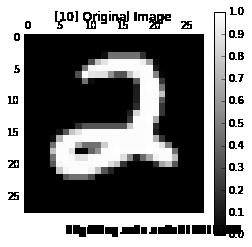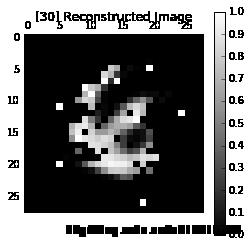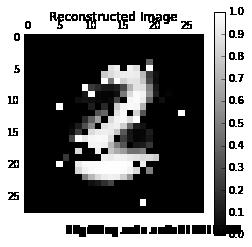tensorflow tutorials:用tensorflow实现降噪自编码器(Denoising Auto-Encoder)
Posted 风雪夜归子
tags:
篇首语:本文由小常识网(cha138.com)小编为大家整理,主要介绍了tensorflow tutorials:用tensorflow实现降噪自编码器(Denoising Auto-Encoder)相关的知识,希望对你有一定的参考价值。
声明:版权所有,转载请联系作者并注明出处: http://blog.csdn.net/u013719780?viewmode=contents
降噪自编码器是Pascal Vincent提出来的,有兴趣的童鞋可以看Pascal Vincent的论文原文Stacked Denoising Autoencoders: Learning Useful Representations in a Deep Network with a Local Denoising Criterion。DAE的核心思想是,一个能够从中恢复出原始信号的表达未必是最好的,能够对“被污染”的原始数据编码、解码,然后还能恢复真正的原始数据,这样的特征才是好的。
DENOISING AUTO ENCODER
In [1]:import numpy as np import tensorflow as tf import matplotlib.pyplot as plt from tensorflow.examples.tutorials.mnist import input_data %matplotlib inline print ("PACKAGES LOADED")
PACKAGES LOADED
MNIST
In [2]:mnist = input_data.read_data_sets('/tmp/data/', one_hot=True) train_X = mnist.train.images train_Y = mnist.train.labels test_X = mnist.test.images test_Y = mnist.test.labels print ("MNIST ready")
Extracting /tmp/data/train-images-idx3-ubyte.gz Extracting /tmp/data/train-labels-idx1-ubyte.gz Extracting /tmp/data/t10k-images-idx3-ubyte.gz Extracting /tmp/data/t10k-labels-idx1-ubyte.gz MNIST ready
DEFINE NETWORK
In [3]:# NETOWRK PARAMETERS n_input = 784 n_hidden_1 = 256 n_hidden_2 = 256 n_output = 784 # PLACEHOLDERS x = tf.placeholder("float", [None, n_input]) y = tf.placeholder("float", [None, n_output]) dropout_keep_prob = tf.placeholder("float") # WEIGHTS weights = 'h1': tf.Variable(tf.random_normal([n_input, n_hidden_1])), 'h2': tf.Variable(tf.random_normal([n_hidden_1, n_hidden_2])), 'out': tf.Variable(tf.random_normal([n_hidden_2, n_output])) biases = 'b1': tf.Variable(tf.random_normal([n_hidden_1])), 'b2': tf.Variable(tf.random_normal([n_hidden_2])), 'out': tf.Variable(tf.random_normal([n_output])) # MODEL def denoise_auto_encoder(_X, _weights, _biases, _keep_prob): layer_1 = tf.nn.sigmoid(tf.add(tf.matmul(_X, _weights['h1']), _biases['b1'])) layer_1out = tf.nn.dropout(layer_1, _keep_prob) layer_2 = tf.nn.sigmoid(tf.add(tf.matmul(layer_1out, _weights['h2']), _biases['b2'])) layer_2out = tf.nn.dropout(layer_2, _keep_prob) return tf.nn.sigmoid(tf.matmul(layer_2out, _weights['out']) + _biases['out']) # MODEL AS A FUNCTION reconstruction = denoise_auto_encoder(x, weights, biases, dropout_keep_prob) print ("NETOWRK READY")
NETOWRK READY
DEFINE FUNCTIONS
In [4]:# COST cost = tf.reduce_mean(tf.pow(reconstruction-y, 2)) # OPTIMIZER optm = tf.train.AdamOptimizer(0.01).minimize(cost) # INITIALIZER init = tf.initialize_all_variables() print ("FUNCTIONS READY")
FUNCTIONS READY
DEFINE SAVER
In [5]:savedir = "tmp/" saver = tf.train.Saver(max_to_keep=1) print ("SAVER READY")
SAVER READY
TRAIN
In [6]:TRAIN_FLAG = 1 epochs = 50 batch_size = 100 disp_step = 10 sess = tf.Session() sess.run(init) if TRAIN_FLAG: print ("START OPTIMIZATION") for epoch in range(epochs): num_batch = int(mnist.train.num_examples/batch_size) total_cost = 0. for i in range(num_batch): batch_xs, batch_ys = mnist.train.next_batch(batch_size) batch_xs_noisy = batch_xs + 0.3*np.random.randn(batch_size, 784) feeds = x: batch_xs_noisy, y: batch_xs, dropout_keep_prob: 1. sess.run(optm, feed_dict=feeds) total_cost += sess.run(cost, feed_dict=feeds) # DISPLAY if epoch % disp_step == 0: print ("Epoch %02d/%02d average cost: %.6f" % (epoch, epochs, total_cost/num_batch)) # PLOT randidx = np.random.randint(test_X.shape[0], size=1) testvec = test_X[randidx, :] noisyvec = testvec + 0.3*np.random.randn(1, 784) outvec = sess.run(reconstruction, feed_dict=x: testvec, dropout_keep_prob: 1.) outimg = np.reshape(outvec, (28, 28)) # Plot plt.matshow(np.reshape(testvec, (28, 28)), cmap=plt.get_cmap('gray')) plt.title("[" + str(epoch) + "] Original Image") plt.colorbar() plt.show() plt.matshow(np.reshape(noisyvec, (28, 28)), cmap=plt.get_cmap('gray')) plt.title("[" + str(epoch) + "] Input Image") plt.colorbar() plt.show() plt.matshow(outimg, cmap=plt.get_cmap('gray')) plt.title("[" + str(epoch) + "] Reconstructed Image") plt.colorbar() plt.show() # SAVE saver.save(sess, savedir + 'denoise_auto_encoder.ckpt', global_step=epoch) print ("OPTIMIZATION FINISHED")
START OPTIMIZATION Epoch 00/50 average cost: 0.089069



Epoch 10/50 average cost: 0.062760



Epoch 20/50 average cost: 0.060874



Epoch 30/50 average cost: 0.060201



Epoch 40/50 average cost: 0.060007



OPTIMIZATION FINISHEDIn [9]:
# Restore load_epoch = 49 saver.restore(sess, "tmp/denoise_auto_encoder.ckpt-" + str(load_epoch))In [10]:
# Test one randidx = np.random.randint(test_X.shape[0], size=1) orgvec = test_X[randidx, :] testvec = test_X[randidx, :] label = np.argmax(test_Y[randidx, :], 1) print ("label is %d" % (label)) # Noise type ntype = 2 # 1: Gaussian Noise, 2: Salt and Pepper Noise if ntype is 1: print ("Gaussian Noise") noisyvec = testvec + 0.3*np.random.randn(1, 784) else: print ("Salt and Pepper Noise") noisyvec = testvec rate = 0.15 noiseidx = np.random.randint(test_X.shape[1] , size=int(test_X.shape[1]*rate)) noisyvec[0, noiseidx] = 1-noisyvec[0, noiseidx] outvec = sess.run(reconstruction, feed_dict=x: noisyvec, dropout_keep_prob: 1) outimg = np.reshape(outvec, (28, 28)) # Plot plt.matshow(np.reshape(orgvec, (28, 28)), cmap=plt.get_cmap('gray')) plt.title("Original Image") plt.colorbar() plt.matshow(np.reshape(noisyvec, (28, 28)), cmap=plt.get_cmap('gray')) plt.title("Input Image") plt.colorbar() plt.matshow(outimg, cmap=plt.get_cmap('gray')) plt.title("Reconstructed Image") plt.colorbar() plt.show()
label is 2 Salt and Pepper Noise



In [11]:
# Visualize Filter from PIL import Image def scale_to_unit_interval(ndar, eps=1e-8): """ Scales all values in the ndarray ndar to be between 0 and 1 """ ndar = ndar.copy() ndar -= ndar.min() ndar *= 1.0 / (ndar.max() + eps)